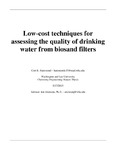Low-Cost Techniques for Assessing the Quality of Drinking Water from Biosand Filters (thesis)

View/
Author
Hammond, Cort B.
Subject
Washington and Lee University -- Honors in Engineering
Water quality -- Measurement
Water filters
Membrane separation
Water -- Purification -- Filtration
Metadata
Show full item recordDescription
Thesis; [FULL-TEXT FREELY AVAILABLE ONLINE] Cort B. Hammond is a member of the Class of 2015 of Washington and Lee University. Over 4 million people worldwide are estimated to benefit from the biosand filter (BSF), an inexpensive point-of-use (POU) water treatment technology designed to remove turbidity, bacterial contamination, and parasites. The effectiveness of biosand filters can depend on initial quality of the source water. Also, the commissioning, operation, and maintenance of the filters, if performed incorrectly, can result in low-quality water. Water quality is typically assessed via field measurements of turbidity and conductivity and laboratory methods such as bacterial assays, microcopy, and colorimetry. Turbidity and conductivity instruments enjoy widespread use since they are low cost, low complexity, and provide results quickly. However, lab analyses are required in order to get a true measure of how safe the water is for human consumption especially if the contaminants of concern are bacteria or trace metals. Lab analyses are often not available or prohibitively costly in areas where biosand filters are used. The limited meaning of field assays and the high cost of lab analyses leave a gap for an intermediate cost tools that can provide more meaningful results in the field. This work describes a Filter Clogging Assay (FCA) where the fouling rate of a 0.2 micron syringe filter is measured as a proxy for bacterial contamination. Ultimately, the (FCA) proved to be promising, with a strong correlation (R2 = 0.93, p = 6.5E-10) between the filter clogging rate and total coliforms and an average analysis time of 14.5±1.5 minutes. The average cost of each analysis is approximately $1.50. This novel method would allow a sample to be assigned one of the four World Health Organization pathogenic risk categories allowing more rapid decision making.